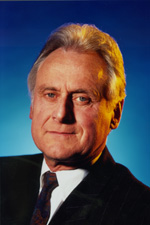|
A Program to Push Things Forward
-Installed photovoltaic capacity in Germany to be expanded ten-fold
(SZ) With the 100,000 rooftops program that he has now put forward, Germany's Federal Economics Minister Werner Müller has presented the most ambitious solar program of its type in the world. It far outstrips a corresponding promotional instrument in Japan. The industry is correspondingly optimistic about the effect this will have on solar technology. Gernot J Oswald, President and CEO of Siemens Solar GmbH, expects a ten-fold increase in installed photovoltaic capacity within six years.
SZ: Germany now has the largest program in the world to promote solar energy. What do you expect it to achieve?
Oswald: Since this program was announced before the elections, numerous projects have been postponed in expectation of better promotional conditions. I assume that this backlog, which has resulted in a drastic collapse in the German market, will now resolve itself rapidly. In addition, we expect a development similar to that in Japan, where, after the introduction of a "70,000 rooftops" program, the market has doubled within two years.
SZ: What will such a program cost and what investment sum will it release?
Oswald: The estimated costs are around DM one billion over six years. In addition, there are the programs from the states and municipalities in Germany and the promotion of research and development. With new investment, we in photovoltaics anticipate around DM 3-4 million for each megawatt (MW) of production capacity. Additional investment is expected for manufacturing and materials suppliers.
SZ: There are critical voices that feel that the program is not sufficient. Do you also see it this way?
Oswald: Sometimes policy is confused with wishful thinking. It was particularly important to act quickly and unbureaucratically. I think that we have taken a big step in the right direction in record time. An important fact is that it can be used in conjunction with other promotional measures to provide options for expanding the program while it is running. We should all make the effort to help shape these options appropriately.
SZ: Is the German solar cell industry in any position to handle a program of this type. Does it have sufficient production capacity or will it now have to do a great deal of stocking up?
Oswald: The photovoltaics business is quite international. So we are by no means on our own. The worldwide capacity is currently twice as large as the market. At the moment, it is more a case of retaining plants and jobs. The situation with German installation companies is different however and they are sure to have to make investments and take on extra staff very soon.
SZ: Given these aspects, how will solar energy's share of energy consumption as a whole develop?
Oswald: The program envisions a ten-fold increase in the installed photovoltaic capacity in the FRG over six years. The proportion of photovoltaics in power generation is then still extremely small but if the desired growth over the six-year period were to continue over the long term, we would reach a figure of almost five percent of power consumption by the year 2020.
SZ: Is the program designed in such a way that the consumers will accept it?
Oswald: The keyword here is the cumulative abilities of the program with promotional measures from the states and municipalities in Germany which hopefully should continue unchanged or even better in an expanded form. For many of those interested in this program the availability of investment resources plays a major role. The 100,000 rooftops program is an ideal addition here.
SZ: There has already been a 1,000 rooftops program and there was a sharp downturn when this came to an end. Is this program now the critical mass, which is right for a market breakthrough for this technology?
Oswald: A program arranged to run for six years provides good opportunities for meaningful planning. However it will be far longer until photovoltaics can compete fully with electricity produced by thermal power stations.
SZ: Does it really make sense to subsidize a technology over many years when it is obvious that even thereafter it cannot hold its own in the market?
Oswald: Photovoltaics already has market opportunities wherever there is no grid connection to a nearby power station. The market opportunities in industrialized countries with a dense power grid will depend over the longer term on the political will to supplement thermal power stations with renewable energy sources. Ever more people believe that this is worth the effort and that photovoltaics will have a significant contribution to make over the next century. Regional developments to date lead us to expect that the Japanese photovoltaics industry – thanks to MITI – is moving ahead of the rest of the world both technically and economically at a rapid pace. The German 100,000 rooftops program is a suitable way of stopping this trend.
SZ: Can such a program also stimulate technological progress?
Oswald: Technological progress is closely linked to market size and market development. In the final analysis – except in Japan – even with photovoltaics the majority of resources for research and development must be earned by the industry itself.
|